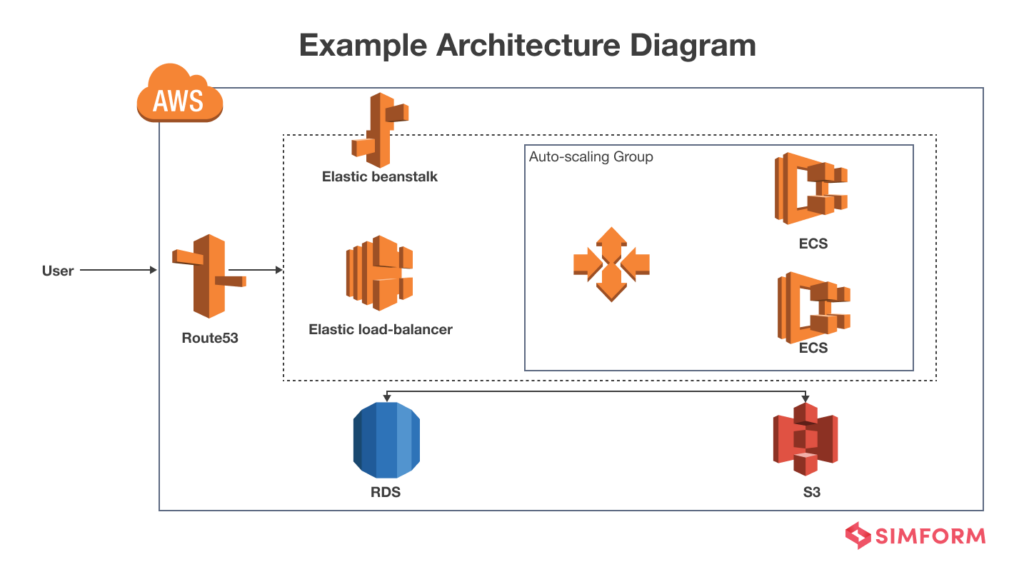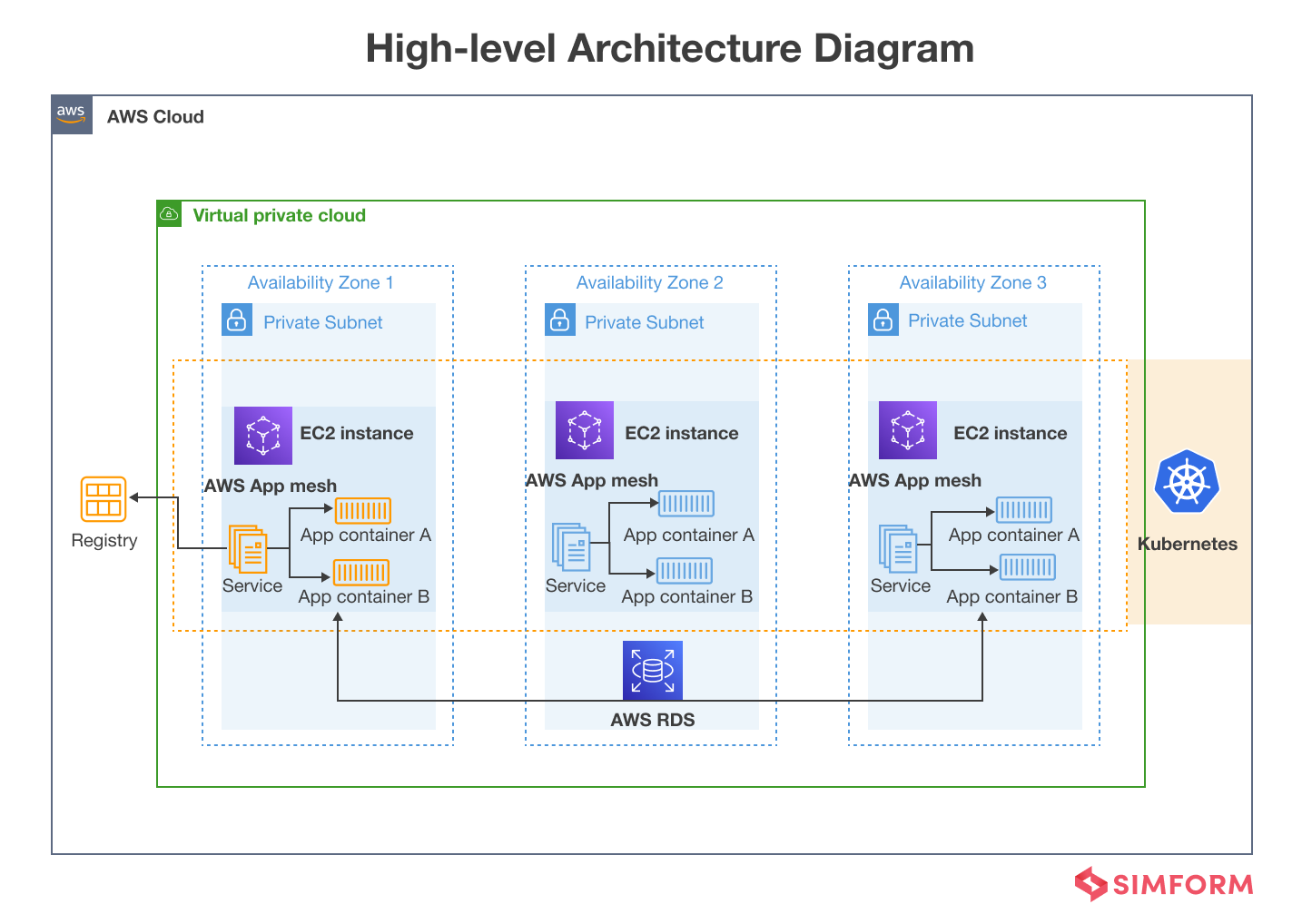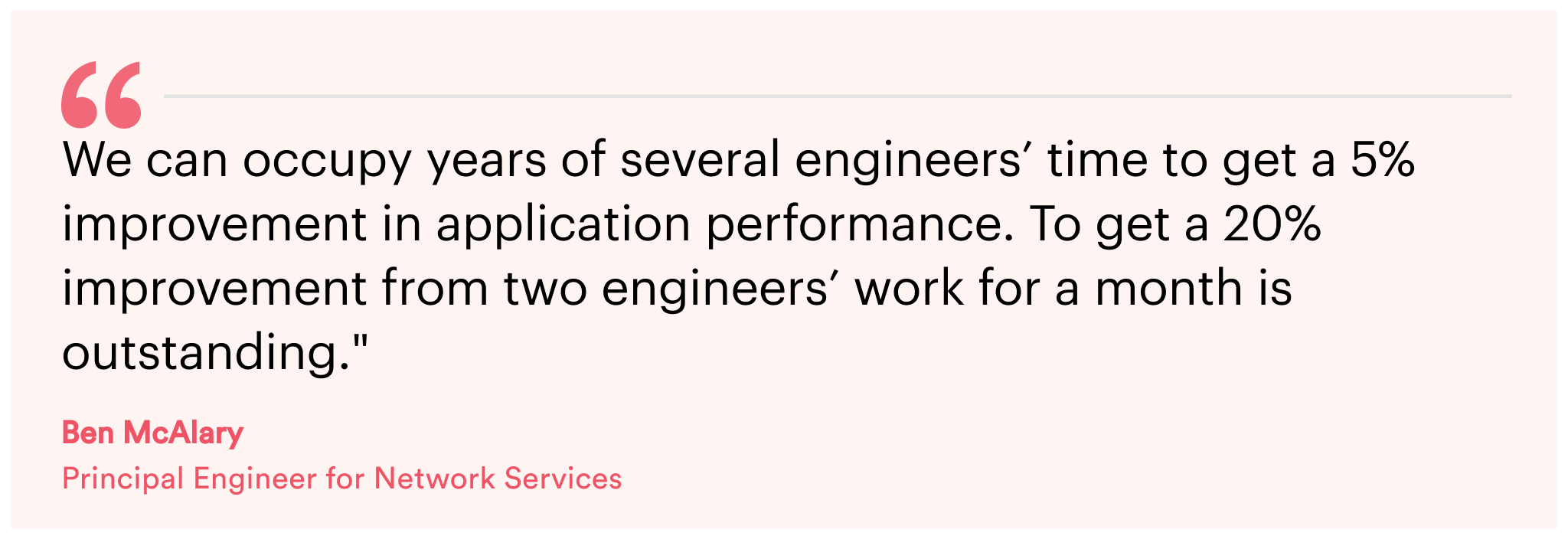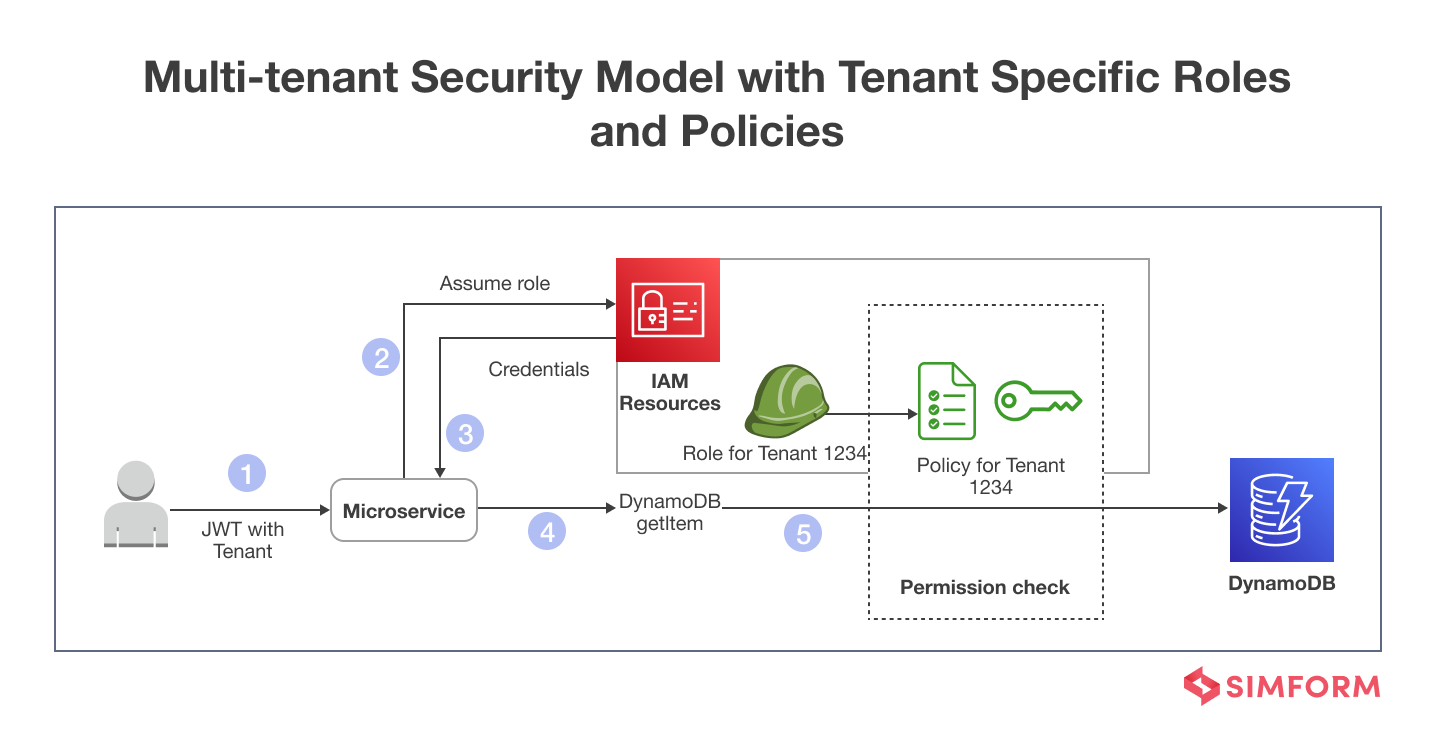How about living in a world where your SaaS application effortlessly scales with growing demand, handles unexpected traffic spikes without a hitch, and benefits from cutting-edge technology while maintaining robust security!? Sounds like a dream come true, doesn’t it? That’s precisely what Amazon Web Services can offer when you migrate your SaaS application to their platform.
The SaaS market reached a big milestone of USD 261.15 billion in 2022, and it’s expected to keep growing at a solid rate of 13.7% every year from 2023 to 2030. As the SaaS market flourishes, businesses are compelled to seek the most advantageous platforms to host their applications and maintain a competitive edge. AWS emerges as the platform of choice, boasting an impressive track record of hosting SaaS giants like Adobe, Slack, and Atlassian.
In this article, we’ll discuss various advantages of migrating your SaaS application to AWS, shedding light on how it empowers you to leverage advanced technologies like AI, machine learning, and serverless computing.
We’ll also delve into the vast array of services and tools offered by AWS, designed to empower businesses like yours to create next-generation SaaS applications. So, get ready to start your journey to a more agile, efficient, and future-ready SaaS application with AWS.
1. Scalability and flexibility: Grow your app effortlessly
Scalability has become a culture as today’s market relies heavily on cloud computing, and companies fail to achieve this fall to the side.
However, true scalability goes beyond simply investing in infrastructure expansion. It’s essential for SaaS applications to grow and adapt to user needs and market conditions. Short-term scalability allows prioritizing essential features initially and gradually adding new functionalities as demand increases. In comparison, long-term scalability enables incorporating new features to enhance client retention and meet evolving market needs, such as upgrading security measures.
How does AWS help?
One of the most significant advantages of AWS is its ability to effortlessly accommodate user growth and high traffic loads. With AWS’s scalable infrastructure, companies can dynamically allocate resources to handle sudden spikes in usage, ensuring a smooth experience for their users.
- AWS services like Amazon EC2 Auto Scaling, Amazon Elastic Load Balancer, Amazon DocumentDB, Amazon RDS, AWS Lambda, Amazon DynamoDB, AWS Elastic Beanstalk, and Amazon CloudFront allow businesses for seamless scaling and customization.
- AWS offers unmatched flexibility when it comes to scaling resources up or down based on demand.
- Whether your SaaS application experiences seasonal peaks or you’re anticipating rapid growth, AWS makes it easy to adjust your resources with just a few clicks, ensuring you’re only paying for what you need. This flexibility allows your business to remain agile and competitive in the ever-changing SaaS landscape.

Gaining insights from real-world examples
Slack, the popular team collaboration platform, relies on AWS to manage its massive user base and handle billions of messages and files each month. Another notable example is Airbnb, which leverages AWS’s scalable infrastructure to accommodate millions of users and listings across the globe.
One of our clients, a fast-growing SaaS startup providing customer relationship management (CRM) solutions, needed a robust and scalable infrastructure to accommodate its rapidly expanding user base. The company decided to migrate its application to AWS, and in just six months, it experienced a 50% increase in user growth with minimal disruption to its services.
By leveraging AWS’s scalable infrastructure, our client was able to accommodate its growing customer base, ensuring a seamless experience for its users and setting itself up for continued success in the competitive CRM landscape.
How to select the best SaaS Architecture?
2. Reliability: Ensure uninterrupted availability
One of the critical aspects of a successful SaaS application is its ability to deliver consistent, seamless experiences to users. Ensuring a successful SaaS application requires not only delivering consistent, seamless experiences but also providing distinct environments and data for each tenant. In this context, a tenant refers to the individual users or clients using the SaaS solution. Each tenant typically has their own separate environment and data within the system.
How does AWS help?
Tenant-aware operations in a SaaS solution help identify any health issues specific to a tenant or the entire system. This allows for early detection and timely resolution of problems, ensuring that the system remains stable, reliable and provides a smooth user experience.
- AWS boasts a highly reliable and available infrastructure, ensuring that your SaaS applications experience minimal downtime and maximum performance.
- Services such as Elastic Load Balancing, Amazon Route 53, and Amazon RDS Multi-AZ deployments contribute to maintaining high availability and fault tolerance for your applications.
- AWS’s infrastructure is designed to ensure that your applications remain online and accessible, even in the face of hardware failures or other unforeseen issues. This level of reliability is crucial for businesses that rely on their applications to drive revenue and maintain customer satisfaction.
- AWS’s global network of data centers and availability zones ensures that your SaaS applications are always within reach of your users, no matter where they are located. This minimizes latency and provides a faster, more responsive experience for users around the world.

Gaining insights from real-world examples
Companies like Netflix and Adobe have trusted AWS to provide the reliability and availability required to support their extensive user bases and maintain the high-quality experiences that their customers have come to expect.
A leading SaaS provider of project management solutions, one of our clients, was facing increasing customer complaints regarding downtime and slow performance. After migrating their application to AWS, we leveraged services like Elastic Load Balancing and Amazon RDS Multi-AZ deployments to improve reliability and achieved a 99.99% uptime rate. This not only improved customer satisfaction but also helped them attract new clients and expand their market share.
3. Cost-efficiency: Optimize expenses with migration
The ability to scale resources up or down as needed ensures optimal performance and helps businesses save money by avoiding overprovisioning or underutilizing resources. This flexibility allows SaaS companies to invest more in innovation and growth rather than being bogged down by high infrastructure costs.
How does AWS help?
AWS offers a range of cost-efficient services and pricing models that help businesses optimize their expenses and increase the ROI of their SaaS applications.
- With AWS’s pay-as-you-go model, businesses can avoid high upfront costs and only pay for the resources they consume.
- Services such as Amazon EC2 Spot Instances and Amazon S3 Intelligent-Tiering, help businesses further reduce operational costs.
- AWS also offers various cost management tools, including AWS Cost Explorer and AWS Budgets, which enable businesses to monitor and optimize their spending. These tools provide valuable insights and recommendations, allowing organizations to make informed decisions about resource allocation and cost management strategies.
Gaining insights from real-world examples
Cost efficiency has played a crucial role in the success of numerous SaaS applications like Dropbox and Zendesk. These companies have harnessed the power of AWS’s cost-efficient services to lower their operational expenses and invest more in their core product offerings.
SilverBlaze, a firm specializing in software innovation, development, and consulting for utility companies, wanted to minimize infrastructure expenses and efficiently address changing demand by transitioning from a colocation data center to the cloud. SilverBlaze successfully migrated 45 servers to AWS, effectively achieving their objectives by leveraging the AWS Application Migration Service.
A growing SaaS provider of marketing automation tools was struggling with increasing infrastructure costs that hindered its ability to scale. After migrating to AWS, Simform helped them utilize Amazon EC2 Spot Instances and AWS Cost Explorer to optimize resource usage and reduce operational costs by 40%. This allowed our client to allocate more resources towards product development and customer support, ultimately resulting in accelerated growth and increased customer satisfaction.
4. Global reach: Expand your SaaS application’s presence
Expanding into new markets is essential for SaaS businesses looking to grow and stay competitive. AWS’s global infrastructure enables businesses to easily deploy their applications in multiple regions, allowing them to cater to the unique needs and preferences of customers in different geographies. This global reach also helps businesses comply with local data regulations and provide lower latency for their users.
How does AWS help?
AWS’s vast global infrastructure that includes data centers and edge locations across multiple continents, provides SaaS businesses with the opportunity to quickly expand their reach and deliver their applications to users around the world.
- Services like Amazon CloudFront, AWS Direct Connect, and AWS Global Accelerator help optimize application performance for global users and ensure a consistent, high-quality experience.
- AWS also offers a wide range of tools and resources, including AWS Marketplace, AWS Training and Certification, and AWS Solutions Architects, to help businesses expand their applications globally. These resources empower businesses with the knowledge and assistance needed to successfully navigate the complexities of global expansion.
Gaining insights from real-world examples
Successful SaaS applications like Salesforce and Atlassian have leveraged AWS’s global infrastructure to expand their reach and deliver services to millions of users worldwide.
By employing AWS Global Accelerator, a networking service that directs user traffic through AWS’s worldwide network infrastructure, Atlassian significantly enhanced internet user performance by up to 60 percent. This implementation allowed Atlassian to position Bitbucket’s edge closer to its users, mitigating potential issues caused by internet service provider (ISP) hops and resulting in improved application performance.
One of our clients, a SaaS provider of e-learning solutions, wanted to expand its services to cater to an international audience. By using AWS’s global infrastructure and services like Amazon CloudFront and AWS Global Accelerator, our client was able to deploy its application in multiple regions and significantly reduce latency for its global users. As a result, they experienced a 30% increase in international user adoption and a 45% reduction in the time required to enter new markets.
5. Security: Enhance protection and compliance
Security is a top priority for any SaaS application, as any breach or vulnerability could potentially result in loss of customer trust and damage to the business’s reputation. Meanwhile, compliance with industry standards and regulations is equally crucial.
How does AWS help?
AWS’s comprehensive security features help to mitigate these risks by providing robust protection against various threats, such as DDoS attacks, unauthorized access, and data leaks.
- These features include Amazon GuardDuty, AWS Identity and Access Management (IAM), AWS Shield, and AWS Key Management Service (KMS), among others.
- AWS also adheres to strict compliance standards, such as GDPR, HIPAA, and SOC, ensuring that your applications meet the necessary regulatory requirements.
- AWS’s infrastructure undergoes regular audits and is designed to meet the strictest compliance requirements, providing businesses with the reassurance that their applications and data are being handled securely and responsibly.
Gaining insights from real-world examples
Successful SaaS applications like Slack and Dropbox rely on AWS’s security and compliance features to protect users’ data and maintain their reputation as trustworthy, secure platforms.
Also, one of our esteemed clients, a SaaS provider of healthcare management solutions, needed to ensure their application was compliant with HIPAA regulations and protected against potential security threats. By migrating to AWS and utilizing services like AWS IAM, Amazon GuardDuty, and AWS KMS, the company was able to significantly enhance its security posture and achieve HIPAA compliance. This enabled them to gain the trust of healthcare organizations, resulting in a 40% increase in customer acquisition.
6. Streamlined management: Simplify operations
Streamlining operations and management helps SaaS businesses reduce overhead, improve efficiency, and ensure that applications run smoothly and reliably.
How does AWS help?
Automation is a key aspect of streamlining operations and management. With AWS, businesses can automate tasks like deployment, scaling, and monitoring, freeing up valuable time and resources for more strategic initiatives.
AWS offers various tools and services designed to simplify the management and monitoring of your SaaS applications, including AWS Management Console, AWS CloudFormation, and Amazon CloudWatch. These tools help you effectively manage your applications’ resources, monitor performance, and automate various operational tasks.
As AWS’s management tools provide a centralized platform to monitor and control your applications, you can easily identify and resolve issues before they impact your users.
Gaining insights from real-world examples
Successful SaaS applications like Atlassian and Zendesk have leveraged AWS’s management tools to streamline their operations and ensure the consistent performance and reliability of their applications.
A SaaS provider of customer support solutions was struggling with managing their growing infrastructure and maintaining application performance. Simform helped migrate their application to AWS. Using services like AWS CloudFormation and Amazon CloudWatch, we automated and simplified their operations, resulting in a 30% reduction in operational costs and a 25% improvement in application performance. This enabled the company to focus on enhancing its product offering and delivering a superior experience to its users.
Supercharge your SaaS with AWS
As we’ve seen, migrating SaaS applications to AWS offers many benefits, including scalability, security, and cost savings. These advantages contribute to improved application performance and pave the way for business expansion and innovation.
However, challenges may arise in the journey of SaaS migration to AWS due to a lack of technical expertise, security concerns, and difficulties in devising effective migration strategies. This is where partnering with an experienced AWS Premier Consulting Partner like Simform can make all the difference.
Whether you need assistance migrating your existing SaaS application to AWS or want to build a new one from scratch, our team of experts is here to help. Don’t hesitate to explore the potential of AWS SaaS solutions and let us guide you towards a more prosperous future.



